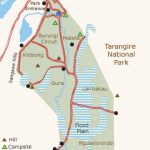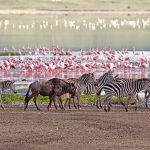Tarangire NP walking & 4WD Safaris
LARGE HERDS OF ELEPHANTS, ZEBRAS, WILDEBEEST AND ORYXES ARE REGULARY SPOTTED DURING DRY SEASON
Tarangire National Park
The park is located 118 km (75 miles) southwest of Arusha.
In the dry season (June – September). When the sun is baking the earth dusty red, the grass as brittle as straw. The Tarangire River has shrivelled to a shadow of its wet season self. But it is full of wildlife. Thirsty nomads have wandered hundreds of kilometers knowing that here, always, there is water.
It is a smorgasbord for predators
Herds of up to 300 elephants scratch the dry river bed for underground streams, while migratory wildebeest, zebra, buffalo, impala, gazelle, hartebeest and eland crowd the shrinking lagoons. It’s the greatest concentration of wildlife outside the Serengeti ecosystem. It is also a smorgasbord for predators – and the one place in Tanzania.
550 bird varieties
The swamps, tinged green year round, are the focus for 550 bird varieties. Bird-lovers might keep an eye open for screeching flocks of the colourful yellow-collared lovebird. You find the Kori bustard, the heaviest flying bird; the ostrich, the world’s largest bird; and small parties of ground hornbills blustering like turkeys.
Old termite mounds are often frequented by colonies of the dwarf mongoose, and pairs of red-and-yellow barbet, which draw attention to themselves by their loud, clockwork-like duetting. Tarangire’s pythons climb trees, as do its lions and leopards, lounging in the branches where the fruit of the sausage tree disguises the twitch of a tail.
HOW TO GET THERE
Easy drive from Arusha or Lake Manyara following a surfaced road to within 7km (four miles) of the main entrance gate; can continue on to Ngorongoro Crater and the Serengeti. Charter flights from Arusha and the Serengeti.
WHAT TO DO
Guided walking safaris.
Day trips to Maasai and Barabaig villages, as well as to the hundreds of ancient rock paintings in the vicinity of Kolo on the Dodoma Road.
WHEN TO GO
Year round but dry season (June – September) for large numbers of animals.
SIZE
2.600 sq km (1.005 sq miles).
ACCOMMODATION
One lodge, one tented lodge, one luxury tented camp inside the park, another half-dozen exclusive lodges and tented camps immediately outside its borders. Camp sites in and around the park.
Contact Form
If you want to contact Mkomwa. Or if you have a question.
Please fill this form and he will get back to you!


